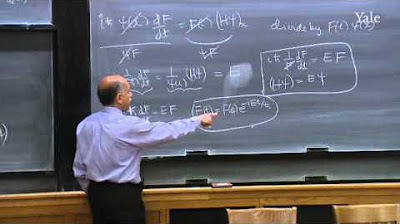The Theory that Solves "Unsolvable" Quantum Physics Problems - Perturbation Theory
TLDRIn this video, the host, Parth, dives into the intricacies of quantum mechanics, specifically focusing on the challenges of solving the Schrödinger equation for complex systems. He introduces perturbation theory as a clever method to approximate wave functions and energy levels when exact solutions are elusive. Using a simple quantum system as a base, Parth explains how small modifications or 'perturbations' can lead to slight shifts in the system's properties, which can be calculated to find approximate solutions. The video also features a magic trick related to card handling, showcasing the mathematical principles behind it, and highlights the educational platform 'One Dream' for its role in sponsoring the content. The host encourages viewers to engage with the material and offers additional resources for a deeper understanding of the topics discussed.
Takeaways
- 📚 Perturbation theory is a method used in quantum mechanics to approximate solutions to problems that are difficult to solve directly.
- 🧮 Quantum systems can be described by wave functions, which contain all the information about the system, such as the probability of finding an electron in different locations.
- 🔍 The Schrödinger equation is crucial in quantum mechanics for determining the allowed wave functions of a system by plugging in the system's properties like kinetic energy and potential.
- 🚫 Some quantum systems are challenging to solve because the Schrödinger equation can become very complex, leading to unsolvable differential equations with current techniques.
- 🤹 Perturbation theory works by taking a solvable system and modifying it slightly to match the unsolvable one, using the original wave functions as a basis for approximation.
- ⚖️ The theory is most effective when the system to be solved is close to a known system, with small changes making the approximation more accurate.
- 📈 Energy levels and wave functions for quantum systems are quantized, meaning particles can only have specific energy levels, each with a corresponding wave function.
- 🛠️ By introducing a small change to a known system (like a 'bump' in the potential well), the new system's energy levels and wave functions shift slightly, allowing for an approximation.
- 🔢 The Hamiltonian of the new system, which is part of the Schrödinger equation, can be expressed as the original system's Hamiltonian plus the small change (perturbation).
- 🃏 A magic trick involving card handling was demonstrated, highlighting the application of mathematical principles in seemingly unrelated contexts.
- 🌟 One Dream, the sponsor of the video, offers a subscription service with a variety of educational and entertaining content, promoting learning across diverse topics.
Q & A
What is the purpose of a wave function in quantum mechanics?
-A wave function in quantum mechanics is a mathematical function that contains all the information about a quantum system. It can tell us the probability of finding a particle, such as an electron, in different locations or positions in space.
How do we determine the allowed wave functions for a quantum system?
-We determine the allowed wave functions for a quantum system by using the Schrödinger equation. We input the properties of the system, like the kinetic energy of the particle and any potential it is in, into the equation and solve it to find the allowed wave functions.
What is perturbation theory and how is it used in quantum mechanics?
-Perturbation theory is a technique used in quantum mechanics when the Schrödinger equation for a system is difficult to solve directly. It involves taking a system that is known and slowly modifying it to match the unknown system. The allowed wave functions of the unknown system can be approximated in terms of the known system's wave functions.
Under what conditions does perturbation theory work best?
-Perturbation theory works best when the system being studied is close to a known system, essentially the original system plus a small change. The smaller the change, the more effective the perturbation theory is in approximating the wave functions and energy levels.
What is quantization and how does it relate to energy levels in quantum systems?
-Quantization is the idea that a particle in a quantum system can only have specific, discrete amounts of energy. This is an interesting feature of quantum mechanics, and each energy level corresponds to a wave function that describes the probability distribution of the particle in space.
How can perturbation theory help in approximating the wave functions and energy levels of a similar, but unsolvable system?
-Perturbation theory can be used to approximate the wave functions and energy levels of a similar system by considering the system as a known system plus a small perturbation. The new system's wave functions and energy levels can be approximated as the original system's plus corrections that account for the perturbation.
What is the significance of the term 'lambda' in perturbation theory?
-In perturbation theory, 'lambda' is a parameter that takes values between 0 and 1. It allows for the simulation of the perturbation being switched on gradually. It is particularly useful in the mathematical steps required to apply perturbation theory.
Can you explain the concept of 'perfect shuffles' as mentioned in the magic trick?
-A perfect shuffle, also known as a Farrow shuffle, is a method of shuffling a deck of cards where every other card is interlaced from the top half of the deck with the bottom half. It is used to move a specific card to a random position in the deck based on binary representation of the desired position.
What is the expectation value in quantum mechanics and how does it relate to perturbation theory?
-The expectation value in quantum mechanics is the average value of a quantity calculated for a quantum system. In the context of perturbation theory, it is used to describe the first-order change in energy levels when the system is in the original energy states plus the perturbation.
What is One Dream and how does it relate to the content of the video?
-One Dream is an educational and entertaining video subscription service that offers a curated collection of videos, tutorials, and documentaries. It is mentioned in the video as the sponsor, and the content creator uses it to further his knowledge in various fields, including the ones discussed in the video.
How does the first-order correction in perturbation theory help in understanding the new energy levels of a system?
-The first-order correction in perturbation theory provides the largest change in the energy levels due to the perturbation. By calculating this first-order change, which is relatively simple compared to higher-order corrections, we can get a good approximation of the new energy levels of the system.
What is the role of the original wave function in calculating the first-order change in energy levels?
-The original wave function plays a crucial role in calculating the first-order change in energy levels. It is used in conjunction with the perturbation to determine the magnitude of the energy shift. This is a simplified process compared to solving complex differential equations.
Outlines
🎓 Introduction to Quantum Mechanics and Perturbation Theory
The video begins with a sponsorship acknowledgment to 'One Dream' and introduces the topic of quantum mechanics problems that are difficult to solve without the aid of perturbation theory. The host, Parth, explains that quantum systems can be described by wave functions, which are mathematical functions containing all the information about the system. The wave function, particularly for a single electron, can tell us the probability of finding the electron in different locations. The Schrödinger equation is introduced as the key to finding the allowed wave functions for a system by plugging in the system's properties. However, for some complex systems, solving the Schrödinger equation can be challenging. The concept of perturbation theory is presented as a method to approximate wave functions for difficult-to-solve systems by starting with a solvable system and then making small modifications to it. The theory is most effective when the new system is similar to the original one, with only minor changes.
🧲 Perturbation Theory and Quantum Systems
The second paragraph delves deeper into the application of perturbation theory. It discusses how a small change in a system, such as introducing a charged particle into a potential well, can slightly alter the energy levels and wave functions. The Hamiltonian for the new system is expressed as the sum of the original system's Hamiltonian and the small change. The video uses a card handling magic trick to illustrate the concept of moving a card to a random position in a deck using perfect shuffles and binary numbers, highlighting the mathematical underpinnings of the trick. The paragraph also introduces 'One Dream' as a sponsor, describing it as a platform for educational and entertaining content. The host encourages viewers to check out the platform and provides a link for a free trial.
🔬 Approximating Wave Functions and Energy Levels
The final paragraph focuses on the practical application of perturbation theory to approximate the wave functions and energy levels of a quantum system. It explains that the first-order change in energy levels can be calculated using the perturbation and the original system's wave function, without needing to solve complex differential equations. The approximation for the new energy levels is given by the original energy levels plus the first-order correction. The wave functions for the new system can also be approximated, although this is slightly more complex. The video mentions that higher-order corrections can provide more accurate approximations but are generally less significant. The expectation value of the perturbation operator is introduced as a term in quantum mechanics, and the host expresses interest in making a video to explain this concept in more detail. The video concludes with a call to action for viewers to like, subscribe, and support the content through Patreon and merchandise purchases.
Mindmap
Keywords
💡Quantum Mechanics
💡Wave Function
💡Schrodinger Equation
💡Perturbation Theory
💡Potential Well
💡Quantization
💡Hamiltonian
💡Energy Levels
💡First Order Change
💡Expectation Value
💡One Dream Sponsorship
Highlights
Perturbation theory is introduced as a method to solve difficult quantum mechanics problems.
Quantum systems can be described by a wave function containing all information about the system.
The Schrödinger equation is used to find the allowed wave functions of a quantum system.
Certain quantum systems can lead to very complicated differential equations that are hard to solve.
Perturbation theory allows for an approximation of wave functions for systems that are close to a known solvable system.
The smaller the change from the original system, the more effective perturbation theory is.
Energy levels and wave functions for quantum systems are explained using the example of a particle in a potential well.
Quantization is a key feature of quantum mechanics, where particles can only have specific energy levels.
Perturbation theory can be used to approximate the wave functions and energy levels of a similar, yet unsolvable system.
The Hamiltonian of the new system is expressed as the old system's Hamiltonian plus a small change.
A magic trick involving card handling and the mathematics of perfect shuffles is demonstrated.
The magic trick's mathematics is based on a course by Arthur Benjamin on simple mathematical magic tricks.
One Dream, the sponsor of the video, is introduced as an educational video subscription service.
The new system's wave functions are approximated as the original system's wave functions plus small tweaks.
The first order change in energy levels is the most significant and can be calculated for an approximation.
The expectation value of the perturbation operator is used to calculate the first order correction to energy levels.
Higher order corrections can provide more accurate approximations but are more complex and often unnecessary.
The video concludes with a call to action for viewers to support the content creator on Patreon.
Transcripts
Browse More Related Video
5.0 / 5 (0 votes)
Thanks for rating:





